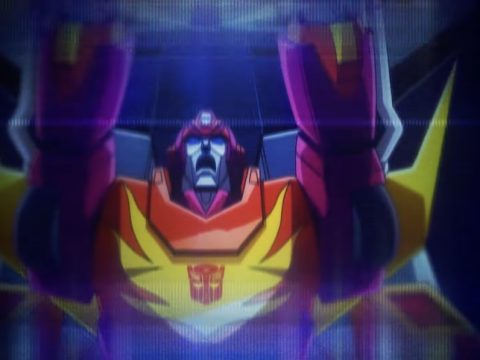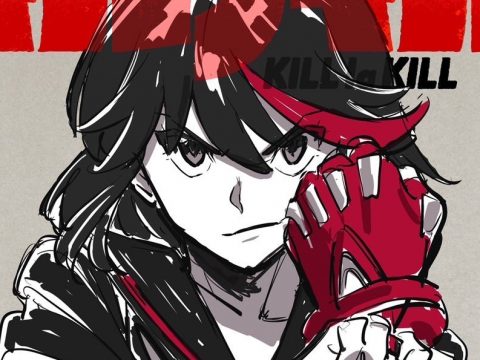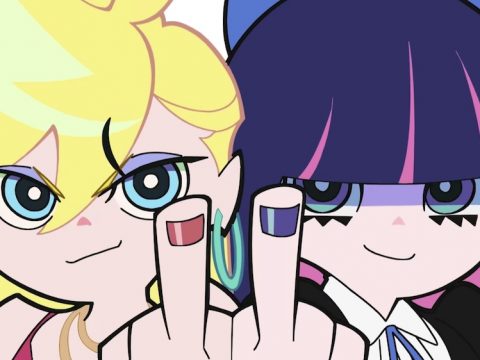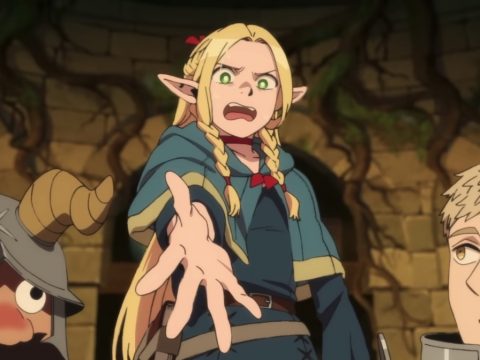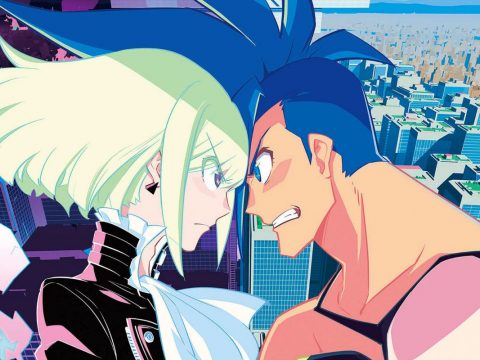The studio behind Kill la Kill rides into the danger zone with DARLING in the FRANXX.

Set in a post-apocalyptic desertscape where teams of teenage mecha pilots protect massive domed cities called Plantations from marauding bands of giant robots known as klaxosaurs, DARLING in the FRANXX never plays quite so wildly as its pedigree, its plot, and its most major motif might suggest. The latest effort from studio Trigger (and co-producer A-1 pictures), FRANXX initially tries to sell itself as a rowdy sexual adventure with an antiauthoritarian streak not entirely dissimilar from what one might expect from the studio that gave us Kill la Kill and from a director like Atsushi Nishigori, who previously cut his teeth as an animation director on and the character designer for the similarly antipatrician Gurren Lagann.
Teenage pilot Hiro and his comrades power the titular FRANXX they use to protect the Plantations not simply by synching their brainwaves with the machine or with a partner (a common enough practice in mecha series) but by lying in the cockpit in poses that don’t so much suggest sex as stop seconds from showing it and that are often accompanied by moaning, grunting, and double entendres so bald they might better be described as “single entendre.” Their ominous masked adult keepers refer to the male pilots as “stamen” and the female pilots as “pistil” when they’re not simply referring to them as Parasites or by the numbers they were assigned at birth, an act that simultaneously defines them in purely sexual terms while reducing them to their use as tools; the teenagers in turn define themselves entirely by their “performance,” bragging or fretting endlessly based on how well they work with their partner.

At no point do Nishigori and his collaborators try to disguise their intentions. There is no subtext here, just text so deliberate and so reminiscent of Kill la Kill’s own pointed and trashy approach that one can’t help but think the writers are dead-set on offering up a hot-blooded commentary on the evils of darkly utilitarian systems that would quash human individuality for some nebulous “greater good.” That the vibrant metallic of the color palette and Masayoshi Tanaka’s character designs recall director Nishigori’s own work on Gurren Lagann so closely so often even leaves the series looking less like an homage than a direct continuation: for all their resemblance, the brainy Goro could be Kittan from an alternate reality where he pursued more scholarly ends; Hiro looks just as Simon might have in those years we skipped over between the first and second halves. What’s here owes such obvious debts visually and philosophically to its most prevalent predecessors that it’s nearly impossible to expect anything beyond another hot-blooded mecha series heavy on spectacle and boisterous emotion displays but light on introspection.
Yet for all that it bears in common with its direct antecedents and with other mecha romps like Goddanar or Aquarion Evol that have used sexual tensions and energy as grist for their adrenaline fueled mill, Franxx is surprisingly subdued. What emerges in the introductory arc offered by the seven episodes available at the time of this writing is a picture of something more meditative, a character study of adolescent frustrations and sexual confusion that’s clumsily positioning itself to bear as much in common with Eureka Seven as it does with Kill la Kill. Fights are strangely low key affairs: while Hiro and his co-pilot 002, a mysterious girl rumored to have Klaxxosaur blood and a penchant for exhausting her male partners to the point of death after three sorties, settle most fights in a display of brilliant colors and daring acrobatics, the action leading up to these moments is never particularly bombastic. The rest of the FRANXX stumble and bumble about as their pilots try to adjust to actual combat, reliant more on clumsy punches and swipes than ballistics or stunning final attacks. These teenagers are still novices in all things, as new to piloting as they are to love and to life. Despite what their keepers might think, their lives consist of more than an endless string of skirmishes.

So as not to prove hypocritical, FRANXX devotes much of its run time to chronicling the characters’ day-to-day lives, their sense of self and how this defines them against their peers and their world. Some, like studious and capable squad leader Ichigo, try to disguise their complex new emotions under a veneer of icy competence; others, like elitist Mitsuru, have bought into a system that holds a Parasite’s worth is equal only to their ability and so work against their comrades to bolster their own place. In fact the driving emotion behind so much of the action is the sense of uselessness Hiro feels after discovering that he’s not suited to pilot a Franxx and the consequent joy he feels when he discovers that he and he alone can partner effectively with 002. There’s an acute awareness of the misery that accompanies adolescence in a meritocratic society where you and your peers are viewed as so much chattel, a society eager to pit you against those who would understand you best while denying you the opportunity to develop your own talents and sense of self. At times it even plays to powerful effect: for all that the series’ central metaphor of one-winged birds relying on one another to fly feels schmaltzy, there’s nothing insincere in the moment where 002 and Hiro come to realize that they need one another for far more than piloting. That there is more to their budding affection and their partnership than a selfish desire for advancement and power. Even small details, like the fact that the children are not certain what a kiss is or what, exactly, the term “darling” means, add a texture to the world that makes it that much more believable.
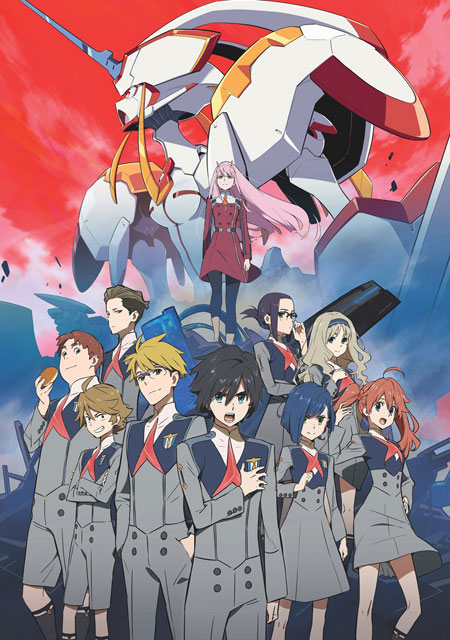 The cast is all well-enough developed, but their characters seem drawn from a bag of immediately recognizable types. Hiro is the ever-kind and considerate but also oblivious: while he has the empathy to give his friends names to free them from the anonymity their assigned serial numbers burden them with, like every other typical nice-guy lead he is completely unaware of classmate Ichigo’s obvious romantic overtures. Futoshi is the requisite quiet and plump gentle giant; Zorome is the confrontational loud-mouth who masks his insecurities with an endless outpouring of braggadocio. Most of these characters feel like they’ve been assigned the most obvious archetypes possible so that viewers can more easily fill in the blanks for themselves. It is also predictable in the paths it chooses to take: the relationships between the characters so far seem as standard as can be, girls and guys pairing off one with another in the most standard dynamics and playing out the same dramatic misunderstandings and simmering frustrations that have been used in every romantic comedy since the genre was born. If this is to truly be a series about challenging the status quo enforced by callous elders, nontraditional relationships and unpredictable, flummoxing interactions would be a welcome addition.
The cast is all well-enough developed, but their characters seem drawn from a bag of immediately recognizable types. Hiro is the ever-kind and considerate but also oblivious: while he has the empathy to give his friends names to free them from the anonymity their assigned serial numbers burden them with, like every other typical nice-guy lead he is completely unaware of classmate Ichigo’s obvious romantic overtures. Futoshi is the requisite quiet and plump gentle giant; Zorome is the confrontational loud-mouth who masks his insecurities with an endless outpouring of braggadocio. Most of these characters feel like they’ve been assigned the most obvious archetypes possible so that viewers can more easily fill in the blanks for themselves. It is also predictable in the paths it chooses to take: the relationships between the characters so far seem as standard as can be, girls and guys pairing off one with another in the most standard dynamics and playing out the same dramatic misunderstandings and simmering frustrations that have been used in every romantic comedy since the genre was born. If this is to truly be a series about challenging the status quo enforced by callous elders, nontraditional relationships and unpredictable, flummoxing interactions would be a welcome addition.
Which is so much the problem: for all that it seems set to preach against conformity and overbearing patricians, DARLING in the FRANXX is an unusually conservative series that takes minor enough risks to feel interesting but takes no risks wild enough to feel as strange or new or subversive as it aspires to be. With all the energy that it’s sitting on and putting front and center, one might expect it to channel that to something more interesting where instead it follows some of the most predictable paths it can. These are early days yet and so there is plenty of time for FRANXX to grow, but the start has been so slow and so careful that one hopes it soon hits a growth spurt.
DARLING in the FRANXX is available from Funimation and Crunchyroll.
This story appears in the August 2018 issue of Otaku USA Magazine. Click here to get a print copy.


